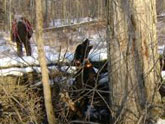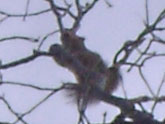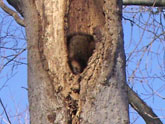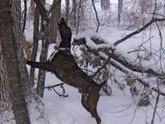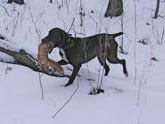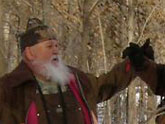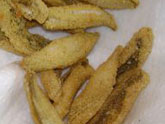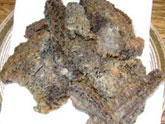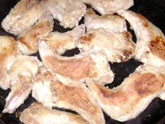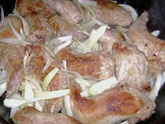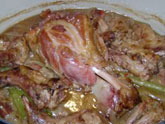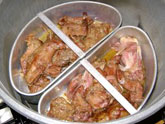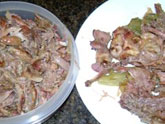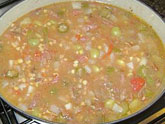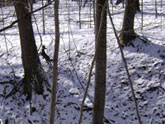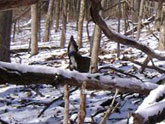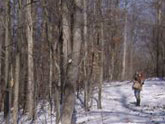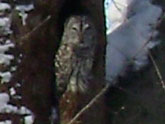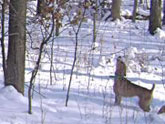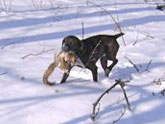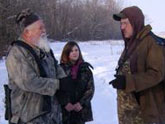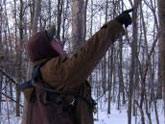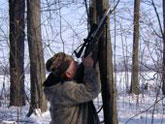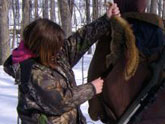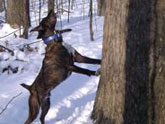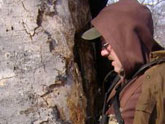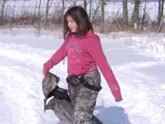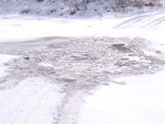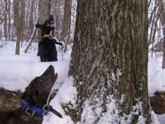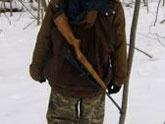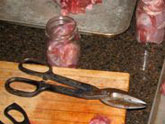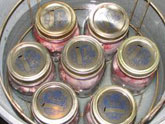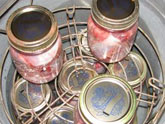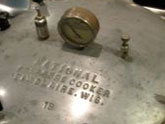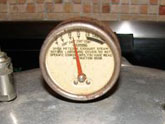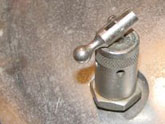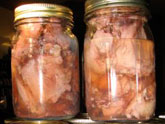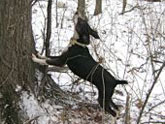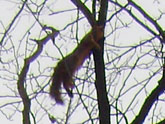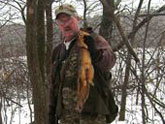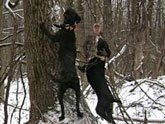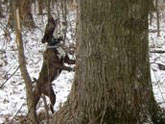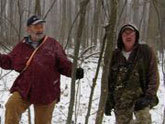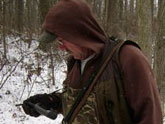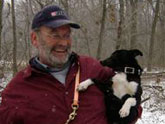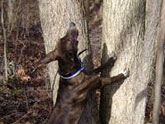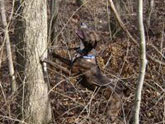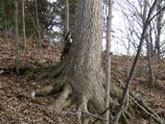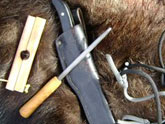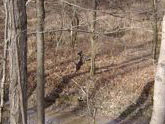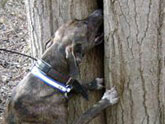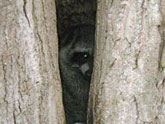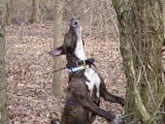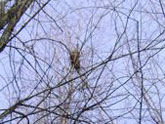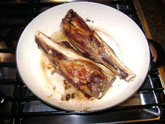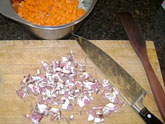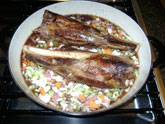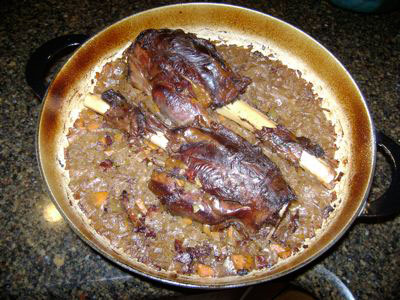January 31, 2009
So It Ends
With temps in the teens, 8 inches of new snow fell Wednesday onto ice-crusted old snow, shutting down businesses and schools and bringing the 2008 squirrel, coon and deer season to a quiet end several days before its legal conclusion on Saturday.
My last hunt was with Joe Wedding on Tuesday. Went to a large woods in the morning, one full of beech, oaks, maple and hickories, with squirrel day beds everywhere. First time this season for this woods. Squirrel paradise, or so it would seem. Yet two new inches of overnight snow showed nothing was stirring, and the few dimples in it revealed little had moved the past several days.
We went to another woods for the afternoon hunt, one where I’d photographed a coon nestled into the top of a beech den a week earlier. Joe speculated at the time that the hollow parts were likely stacked with hibernating coon. We saw the same coon in the same position, and another coon with his ringed tail sticking straight out of the hole below him, like a stubbed off tree limb. I would have taken a picture as I approached, but I figured no hurry, the second coon was dead with his tail frozen stiff—otherwise it would have been wrapped around him inside the hole, right? He was lethargic, but he pulled it in when he heard our approach, and crawled up into the hollowed beech before I could get the camera out.
Except for a day one week prior, when temps moved above freezing, I haven’t seen a coon track during these past three weeks of cold and snow, carrying right through the heart of the rut, and I’d hunted almost every day. I’m hoping these two coon were a mating pair and that they thaw out soon, because all sign otherwise indicates coon procreation was canceled in Ohio for 2009.
The afternoon hunt wasn’t much better. Ice crystal snow makes tough tracking for dogs. The thermals haven’t been right recently for winding, either. Top all that off with squirrels that bail or timber to den trees, panicking when they see you coming through the whiteness on snow that sounds like shards of grinding glass, and it was all we could do to kill one squirrel. Yup. We hunted from 9 a.m. until 4 p.m., slogging through ice and cold, dripping snot much of the way, for one squirrel, and that one treed within 75 yards of our truck as we ended the hunt, whipped.
The highlight of the past week occurred the 23rd, the only day the woods briefly thawed. Tom, Joe and I took Otis and Digger to woods near Joe’s home. The squirrel hunting was good, but lunch was better, especially after an appetite-whetting trek through five inches of snow. Tom had an ice-fishing commitment with his brother for the afternoon. That meant I had to account for his share of a lunch that Meredith, Joe’s wife, prepared for us.
In Marlowe’s “Dr. Faustus”, Mephistophilis bargains for Faustus’ soul with a plate of fresh fruit. The temptation is lost on us with our supermarket selections of Moroccan clementines, Colombian mangoes, and Mexican cantaloupes in January, but think of the astonishment behind a bowl of succulent cherries delivered for your approval in the middle of a 16th century European winter.And didn’t Milton’s Serpent in Paradise Lost bring down Eve and detour all of humanity with an apple at 12 o’clock noon—lunch time?
Joe’s resemblance to a goateed Mephisto is likely a coincidence, and I’m not saying I’d have bargained my soul for the plates of pan-fried morel mushrooms crisped in butter, the servings of homegrown sweet corn, and the baskets of deep-fried Lake Erie perch that Meredith kept relaying to the table smack in the dead of a miserable stretch of winter, but I will admit to a sinful joy while eating the larger portion of Tom’s share.
January 21, 2009
Tough Enough
You don't braise tenderloins and you don't grill chuck roasts. So, too, all squirrel is not equal. Early season young of the year yield nicely to pan-frying. Mature squirrels require braising. Old squirrels may require pressure-cooking. You do what you need to do to make the meat tender.
I started with three old squirrels and used for inspiration a Brunswick stew recipe given to me by my friend Shawn Orbanic, given to him in turn by Ward French, a friend from Georgia who made it with 30 to 50 squirrels in restaurant stew pots to feed a hundred men at Shawn’s clubhouse.
In a 12” cast iron skillet, I browned the seasoned and lightly floured squirrel parts (saddles and legs) in bacon fat. Once accomplished, I deglazed with a large Frenched white onion until it turned translucent.
The squirrel, the onions, four celery stalks, a bay leaf, a can of Swanson’s beef broth, and a smoked pork shank I had on hand that needed using went into a 7 qt. cast iron Dutch oven, and that into a 350 degree oven. After two and one half hours, the meat fell from the shank, but the squirrel showed no signs of yielding to the fork anytime soon. Trouble ahead, so I detoured through a pressure canner/cooker. Ounce for ounce, in life, and apparently after death as well, there’s nothing tougher than an old squirrel.
I brought up from the basement an old cast-aluminum canner with food trays that sit elevated upon a wire rack supported by 3” legs, designed for cooking in a pressurized environment without immersing the foodstuffs in water. Perfect. After half an hour at 12 lbs, the meat slipped from the bones. I pulled it from the shank as well, removed the celery and headed for the home stretch.
To the meat, the broth and the melted onions, I added a bag of frozen Fordhook limas, a bag of cut okra, a bag of home-grown frozen corn, a quart of home-canned tomatoes, more water, three peeled, diced potatoes, a pinch of thyme, some cayenne and some Worcestershire sauce, which I covered and returned to the oven for an additional 30 minutes to cook the vegetables and marry the flavors, adjusting the final seasoning with Tony’s.
The shank crowded the more delicate flavor of the squirrel. The stew could have done without the shank, but it couldn’t do without the squirrel. Some folks cook up a facsimile with chicken if they’ve lost their shootin’ eye, and they call it Brunswick stew, but sayin’ so don’t make it so.
I carried some of this stew to Athens, Ohio, the next day for a hunt with Gary Belcher. Gary’s Pepper female last week had a litter of eight pups sired by Digger. She’s as fine a squirrel dog as you’d want to follow. We’ve been looking forward to this mating for a while, having tried it unsuccessfully nine months earlier. The pups are just now opening their eyes, so Gary left Pepper behind and the two of us followed Digger up and down the hills of S. Ohio for an afternoon.
January 20, 2009
Move'm out
When Jay Overholt parks his truck and heads for the woods, he never stops walking until he gets to his dogs, and they don’t stop going until they tree somewhere. Jay disdains driving. He’d walk to work and go there willingly if he could send his dogs ahead of him. He’d enjoy it all the more if it took 5 hours in single digit cold through 6” snow with a pair of young dogs, like today.
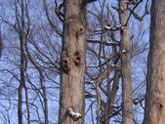 |
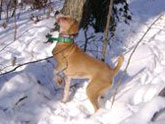 |
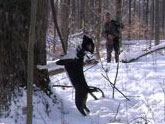 |
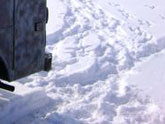 |
January 19, 2009
Getting Warm
Joe Wedding, his brother and his nephew crop farm over 3,000 acres near Raymond, Ohio. When he granted Tom Smith permission to hunt this fall, he expressed an interest in tagging along sometime. Today, Joe and his 11 year old granddaughter Holly took their first squirrel dog hunt.
Temperatures had fallen from the daytime 20’s of yesterday back to single digits, and the cold adversely affected early morning squirrel movement. We parked a truck at either end and sent Otis and Digger into a mile stretch of timber, with a creek through it, bordered on both sides by corn and bean fields—ideal fox squirrel habitat. The hunt yielded only a few trees and one squirrel.
Temperatures began to warm by late morning, and the squirrels made a showing in the second woods, leaving tracks in every direction upon the new snow. We kept busy going from one dog to another, because Otis and Digger usually treed independently of one another.
Holly wants a squirrel dog pup. Joe looks to be a kindly, indulgent grandfather.
January 18, 2009
Getting Out
After almost a week of crunchy snow, sullen skies and night-time temperatures falling to double digit sub-zero numbers, the sun came out today. So did two squirrel hunters. And the squirrels, too, however briefly.
I would have thought weather that cold that long would make thick, safe ice, but I didn’t think about ice forming over running water at a slower rate than ice over ponds and lakes. Two-inch creek ice is almost thick enough to support Tom Smith, me, and two dogs in a Toyota Tundra.
Though the creek bottom at the ford was graveled for the safe passage of heavy farm equipment, we were in deep enough that the truck couldn’t climb up over the ice shelf ahead of us. We backed out and tried again, successfully, but not in a rush, mindful not to slam three-ply tires into an ice barrier. It was otherwise a long walk leading dogs to the woods across plowed and snow-drifted agricultural fields. Since we knew we could back out of the hole, we reasoned that another try was worth the risk.
Tom brought Sis, an elkhound/cur cross, and left Socks and Otis home. We walked new snow through a large woods for three hours and saw nary a deer track or bed, and not the first squirrel track. The deer had yarded up elsewhere. We treed over a dozen times, though. Killed three squirrels and watched two get away.
The sun brought the squirrels out to stretch upon limbs and soak some rays, and as the snow warmed, the thermals dropped their scent to the dogs. Most squirrel dogs depend upon a combination of eyes, ears and scent-tracking ability to tree squirrels. Only a few can also wind squirrels. Beyond that, a good squirrel dog’s accuracy in determining from the wind currents the correct tree remains a wonder to me. Only once did Digger stand on a bank and tree into the wind without selecting a tree. He knew it was close, but couldn’t figure where or which one. On every other occasion, Digger or Sis claimed a tree either with a squirrel in it or visible sanctuary somewhere upon it.
I stepped off a creek bank while I was circling a tree, sifting through its branches for a squirrel, much as the Greek philosopher Thales did when he fell down a well shaft while pondering the stars, and landed awkwardly enough that Tom ended up carrying the squirrels and the rifle. It was, as we say, another good hunt.
January 11, 2009
Pressure Canning Squirrels
Fast food here often means opening a jar of pressure-canned meat. In the time it takes to boil noodles, I can sauté onions and make a sour cream gravy for a flavorful dinner of venison Stroganoff. The squirrel dinner that takes several hours in the oven comes tender from a jar as fast as I can pour off the meat juice for gravy and skillet-brown the parts. Still too much bother and time? I can spoon up a shredded feral hog barbecue sandwich by popping the lid off a pint jar and heating the contents with some Montgomery Inn sauce. Or pull a squirrel leg straightaway from the jar before you can pull up to the microphone at Wendy’s.
I soaked the squirrels whole in a mild brine overnight, rinsed them and reserved two young ones for frying fresh, cutting the balance into parts, bone in. Ribs, belly meat and other trimmings go into a pile for Digger. No waste to the waste.
Widemouth jars work best, but we were out of them. It’s easy enough fitting legs and loins into a standard jar, but more difficult to extract them. A half-inch of headspace and a half tsp of salt in the top of each jar before lidding it, and thassit. The jars are ready for pressure canning. This treatment renders the toughest old squirrel as toothsome and tender as a young of the year.
No need to sterilize the jars or boil the lids and rings first. A hot water soap bath and a rinse suffice. The pressure canner is, after all, a functioning autoclave.
Place the first layer of jars in the pressure canner on a rack and not directly on the canner bottom, with water up to 1/3rd of their height. A second layer also separates by a rack. This 18 qt canner (by volume) will hold 14 pts or 7 qts. It's precisely milled where the lid meets the kettle and therefore requires no gasket. It can't wear out. It's from a different time and place than today, and it works as well now as it did when it was new 75 years ago.
The valve on the right is a needle valve. Unscrew it initially. The valve on the left is a pressure relief valve, spring loaded with a seated steel ball to prevent the top from blowing off if you aren’t attentive to the pressure gauge. After ten minutes of allowing steam to escape through the needle valve and all air to evacuate the chamber, screw down the needle valve without scalding yourself and let the pressure build to 12 lbs. Regulate the heat to make it ride there for 70 minutes for pts, 90 for qts.
When time expires, let everything sit so the contents come down to atmospheric pressure slowly. Don’t try venting off the steam and removing the lid because the jars are under pressure when hot and will blow their juice into the unsealed kettle chamber. Let everything cool naturally.
If jars don't seal, clean off the rims and run them through the 70-minute cycle again with new lids, or else refrigerate and eat the contents within a few days. The finished jars will keep just fine in the basement for years. No freezer burn, no electrical outages to worry about. No degradation of flavor and loss of moisture as is customary with frozen meats.
Canning Do's & Don'ts
You can get better results with an old canner, but it’s required in the bargain that you pay more attention to what you’re doing. Some do’s, don’ts and tips:
Maintain a thin film of Vaseline smeared around the machined rim of your kettle where the lid makes its seal. This will prevent marring or breaking flanges with prybars to loosen the lid after cool-down sucks the fit tighter.
Never cook in cast aluminum kettles and never let them run dry. A dramatic temperature difference between the bottom and the upper reaches of the sides will cause the kettle to distort. Shape is critical to the metal-on-metal lid seal. Always keep a water bath in the bottom. If you want to brown a roast before pressure cooking it in your canner, do it elsewhere.
If you buy an old canner off eBay, or if you salvage one from granny's attic, make sure it has some variation of the three items on the lid dome as pictured here: pressure gauge, pressure relief valve, steam escapement. I’ve also included a photo of a toggle style pressure relief valve common to some old canners. Regardless of the system, check the valve vents to make sure they are free of obstructions before each cook, and that the relief valve spring functions.
The pressure gauge will either register or not. If it does, it’s likely accurate. If you become suspicious of it, you can purchase a new one online or from a hardware store that sells canning supplies.
Lids and kettles are indexed along their edge with corresponding marks. Always mate them.
Torque the lid down as you would an engine head or lug nuts on a wheel, working across diameters a little at a time. Make sure the lid is not cockeyed.
See the broth inside the jars? That's pure essence of squirrel. Not a bit of water was put in the jars. The juice came from the squirrels themselves and makes the most flavorful squirrel gravy you ever tasted, rich and fine beyond description.
You can bone a deer or a feral hog or any other animal, especially the shoulders and hams, which contain collagen and connective tissue, cut them up into 1-2 inch squares, put the pieces in jars, sprinkle a little salt on top, go through the same process and get the same results. Fish work, too. Even bony fish. Smoked fish cans beautifully and keeps for years. I hope to do some this spring when the redhorse suckers run.
These cast aluminum pressure canners are available new for around $250, or used through eBay for about a third of new. Yes, an old, used one sells for more than a new stainless steel one with a rubber gasket and a rocker weight. It’s not sentimentality that makes me favor the old one, though that’s reason sufficient. They are safer in a very important way. Folks selling the newer, thin-walled, rubber-gasketed, stainless-steel versions will challenge that, and we’re familiar with legends of food exploded onto the ceiling. Don’t be fooled. What we’re being sold is not an economical upgrade in safety, but a cheapened product attended by the hazards that usually result from engineering a product failsafe for idiots.
My first pressure canner was stainless with a gasket. It proved a pain in the butt to seal off at the lid, even after twisting the flanges for a tighter friction fit. They’re difficult to keep at a uniform temperature and pressure, too. You have to set the heat so that a balance weight placed over the steam escape valve rocks off its seat to vent steam three to four times a minute. Even the new cast aluminum canners brought over this pressure relief rocker system from the stainless steel canners.
A steady pressure is essential to a safely canned, bacteria-free product. If the weight rocks too rapidly, pressure and temperature constantly fluctuate and the results are unpredictable. If it doesn't rock enough, you don't build sufficient temperature to kill bacteria. By paying attention to what you’re doing, you can dial in the exact heat off the pressure gauge on the old ones, and by checking it periodically you can do it precisely for the duration of the cook. Botulism isn't as spectacular in the imagination as an exploding pressure canner, but my money says it's killed a helluva lot more people.
Be smart, be safe, stay aware and take full responsibility for what you do.
January 10, 2009
Tom tom
I have a checklist for hunting in the company of others. Make sure you are not the only one with a game pouch. Make sure you are not the only one carrying a gun. Make sure not to kill more squirrels than each of you wants to take home. Went hunting yesterday morning with two long-time buddies and got snookered on all three rules.
We hadn’t gone far from the truck when I noticed the first violation. Tom Smith wore a hoody and Tom Lynn had on a heavy shirt. Tom Smith had a game vest in the truck and returned for it.
Tom Smith can’t see through a scope, so he never carries a rifle. His eyes are so bad that when he knocked his glasses off his head mowing the lawn last summer, he groped his way back to the house. Tom Lynn brought along a fiest, 6 months old, that didn’t do much more than run off with a dead squirrel almost half his size and play keep-away. Tom wasn’t hunting so much as giving it woods time. Besides, in case it snowed another two inches, a rifle would have interfered with him carrying his dog. All this meant that when Tom Smith’s two dogs treed in two different directions, and Digger in a third, the two Toms usually split up after them while I walked to three trees, toting a rifle, and squirrels.
It was a hunter’s day, hovering around freezing, with a skiff of new snow on the ground and a front moving in. The temperature made for comfortable walking, the snow meant you could read a woods pretty well, and the front prompted game movement.
We hunted long and hard through big hardwood timber that was new to me and held my attention. A dog was usually treed somewhere, so we spent little time standing around. Because it was the rut and squirrels were seeking each other’s company, we often treed two and sometimes three at once, though I never took more than one from each tree. It was a “good hunt” in the parlance, filled with action, stories and laughter, all seasoned by an unspoken appreciation to be where we were, doing what we were doing.
On the downside, I got so tired from the carrying and the walking, from stumbling over small limbs hidden by snow and tripping over bent stalks of corn stubble frozen to the ground, that the best I could do after returning home was to gut the squirrels and set them out in the cold for attention following a restful night’s sleep. That sleep only came after leg cramps quit seizing various muscle bundles in the calves and thighs of both legs, sometimes simultaneously, while I balanced on toes, stretched, and filled the bedroom with shrieks.
I’d call Tom Smith and go again today, except that we’re scheduled for a freezing rain. More than that, I need to get busy skinning and butchering while Mary assembles the canning supplies from the basement. I’ve got all 12 squirrels to pressure can.
January 5, 2009
Bailout
We got a late start. Squirrels had gone to bed for the morning, so the first 7 trees Digger treed were all dens or leaf nests. While I scanned the 7th tree, a large fox squirrel popped out of its hole, circled the trunk, and tucked back in. I didn’t mind. He looked old and tough.
Digger threw his head up to catch the wind as we were leaving the main woods, headed for a white oak, and fell treed. A heavy-furred black boar coon, in prime condition, lay curled up in the second fork. I brought him out and cased him on the spot while Digger waited.
That's my coon skinning kit lying on the boar. It includes an old Case XX sheath knife, a pocket steel, a pair of osage sticks for stripping out the tail, and some nooses of color-coded parachute cord for hanging the coon off a limb by his back feet during skinning. I carry this kit in my vest squirrel hunting because Digger sometimes trees a daylight coon. Today he treed two.
We no sooner left the woods to retrace our steps to the truck along a feeder creek when Digger treed again. I could see the squirrel from a distance, up a creek bank sapling, and nervous. Before I could set up for a shot, he bailed and made it to a nearby cottonwood tree with Digger snapping at his butt.
He climbed to the top sans his bushy tail. When I shot the squirrel out, Digger grabbed it, shook it, and went back to treeing, baying into a cleft in the trunk at a small coon denned up out of his reach. We left him with his story.
The path back hadn’t yielded a strike on the way in, but squirrels were moving now and Digger soon bushed another. This one bailed too. Digger was too nimble for it and grabbed it up, fetching it back to me after a crunch and a shake.
In scrub stuff near the truck, Digger bushed a third squirrel. For the third consecutive time it bailed upon my approach. This one eluded him, made it up a nearby slender elm, and climbed into a leaf nest. Sanctuary.
Two squirrels, a coon, plenty of action and lots of walking. It was a good late morning hunt to a woods I hadn’t visited for several years. Both squirrel and coon sign proved abundant, so I’ll return before the season ends, but earlier in the morning the next time, or late at night.
January 1, 2009
Venison Shanks
Three of our four daughters came with their families New Years Day. Mary fixed a pot roast and left the pork and sauerkraut to me, but when I went rooting in the basement freezer for a feral hog shoulder to roast, I found two venison shanks. So much for tradition.
While the shanks browned in an enameled cast iron braising pan, I chopped up a mire poix of onion, celery, carrots, and home-smoked bacon ends, richly infused with hickory smoke. Deglazed with some red wine, added a can of Swanson’s beef broth, covered the pan and placed it in a 300º F oven for about 5 hours, until it was pull-apart tender.


